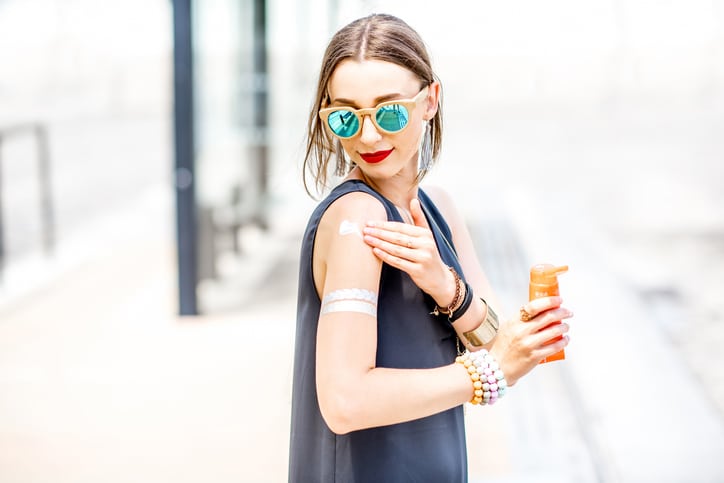
Sunscreens are our protector, helping ward off the damaging UV rays. Putting on sunscreen is ubiquitous nowadays, but it wasn’t always that way. If you’re in your upper 50s or 60s now, you probably remember when the first sunscreens were introduced. The first true sunscreen was called Glacier Cream and later became Piz Buin (which still makes sunscreen lotions today), and it was developed in 1946 by a Swiss chemist. But when Coppertone (the name says it all) came on the market in the 50s, sunscreen lotion began to grow. Of course, it’s estimated now that the early Glacier Cream and Coppertone products had an SPF of 2! Not much protection there.
Today’s sunscreens form a far more effective barrier against the sun. Now they’re waterproof (for awhile) with effective SPFs of 50 (it’s thought that any SPF over that number doesn’t provide any more protection).
Since Dr. Musick sees the effects of too much sun on our patients every day, we like you to have as much information as possible. To that end, here’s a little primer on how your sunscreen blocks the sun from damaging your skin.
Inorganic versus organic
Sunscreens come in sprays, lotions, gels, or waxes, and are made of a mix of chemicals. There are inorganic and organic sunscreens, but they’re not exactly like organic food at Whole Foods. Inorganic chemicals in sunscreen can reflect or scatter the light away from the skin. Organic (carbon-based) chemicals can absorb UV rays so that your skin doesn’t.
Some of the early inorganic chemicals included minerals such as zinc oxide and titanium dioxide and they acted as physical sunblocks. To be effective, they had to be covering the skin. That’s why you saw many people with white noses on area beaches back in the 80s and 90s. The minerals reflected the sun’s UV rays back off the skin just as white paint reflects light. Today’s inorganic particles are much smaller, so users don’t have to look as if they’re covered with white frosting.
Organic chemicals used in sunscreens have names such as avobenzone and oxybenzone. These chemicals don’t reflect or deflect the UV rays; they absorb them. They do this with chemical bonds. As the bonds absorb UV radiation, the components of the sunscreen slowly break down and release heat. This is why these sunscreens have an effective time limit at which point the user would need to reapply.
What is SPF?
There initially was some misunderstanding about the effect of the UV rays. The sun rains down two types of ultraviolet rays onto your skin, UVA and UVB rays. UVB rays cause sunburns. Originally, because the reddened skin from sunburns was so obvious, UVB rays were all anyone worried about. UVB rays affect the epidermis, the skin’s outer layer.
More recently, various research studies have brought the effects of UVA rays into focus. UVA rays penetrate the epidermis into the dermis, the skin’s second layer. It’s thought that UVA rays damage the skin longer term with premature wrinkling, age spots, and other issues. UVA rays don’t cause sunburn, though, so they’re not as obvious. But growing amounts of research point to possible links between UVA rays and the development of melanoma, the most dangerous form of skin cancer.
SPF is how you can judge the protection level of a sunscreen. It stands for Sun Protection Factor, and it refers to how well the sunscreen protects the user against UVB rays. Obviously, SPF came before UVA rays were understood. Now, any sunscreen worth anything is labeled “broad spectrum,” and it protects against both UVB and UVA rays.
It’s recommended to use broad-spectrum sunscreen with SPF between 15 and 50. A sunscreen with SPF 15 protects against about 93 percent of the sun’s UVB rays; SPF 30 blocks 97 percent. No sunscreen provides a 100 percent block.
Now you know your sunscreen, so be sure to get a good broad-spectrum variety and use it. And don’t forget to get your skin checked periodically for skin cancer with Dr. Musick. Call us at (618) 628-2588 to make an appointment.

